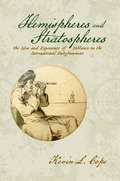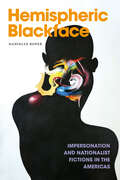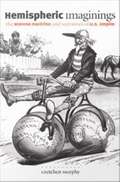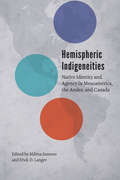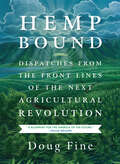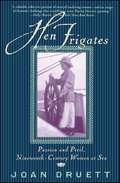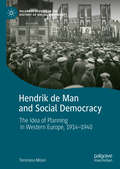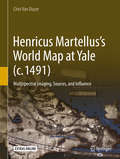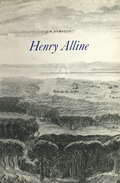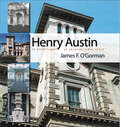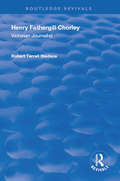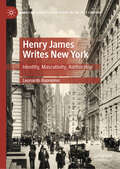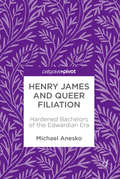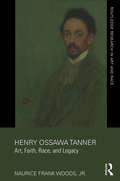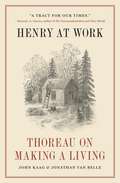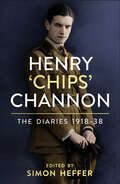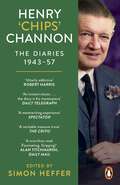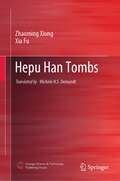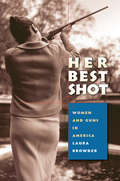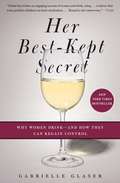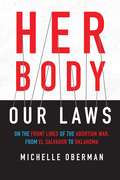- Table View
- List View
Hemispheres and Stratospheres: The Idea and Experience of Distance in the International Enlightenment (Transits: Literature, Thought & Culture 1650-1850)
by Rachel Mann Phyllis Thompson Kevin L. Cope Roger D. Lund William Stargard Bärbel Czennia Brijraj Singh Chandrava ChakravartyRecognizing distance as a central concern of the Enlightenment, this volume offers eight essays on distance in art and literature; on cultural transmission and exchange over distance; and on distance as a topic in science, a theme in literature, and a central issue in modern research methods. Through studies of landscape gardens, architecture, imaginary voyages, transcontinental philosophical exchange, and cosmological poetry, Hemispheres and Stratospheres unfurls the early history of a distance culture that influences our own era of global information exchange, long-haul flights, colossal skyscrapers, and space tourism. Published by Bucknell University Press. Distributed worldwide by Rutgers University Press.
Hemispheric Blackface: Impersonation and Nationalist Fictions in the Americas (Dissident Acts)
by Danielle RoperIn Hemispheric Blackface, Danielle Roper examines blackface performance and its relationship to twentieth- and twenty-first-century nationalist fictions of mestizaje, creole nationalism, and other versions of postracialism in the Americas. Challenging both the dominance of the US minstrel tradition and the focus on the nation in blackface studies, Roper maps a hemispheric network of racial impersonation in Peru, Bolivia, Colombia, Jamaica, Cuba, and Miami. She analyzes blackface performance in the aftermath of the turn to multiculturalism in Latin America, the emergence of modern blackness in Jamaica, and the rise of Barack Obama in the United States, showing how blackface remains embedded in cultural entertainment. Contending that the Americas are linked by repeating nationalist fictions of postracialism, colorblindness, and myths of racial democracy, Roper assesses how acts of impersonation mediate the ongoing power of these narratives and enable people to comprehend advancements and reversals in racial equality. Rather than simply framing blackface as liberatory or oppressive, Roper traces its emergence from a shared history of slavery and the varied politics of racial enjoyment throughout the hemisphere.
Hemispheric Imaginings: The Monroe Doctrine and Narratives of U.S. Empire
by Gretchen MurphyIn 1823, President James Monroe announced that the Western Hemisphere was closed to any future European colonization and that the United States would protect the Americas as a space destined for democracy. Over the next century, these ideas--which came to be known as the Monroe Doctrine--provided the framework through which Americans understood and articulated their military and diplomatic role in the world. Hemispheric Imaginings demonstrates that North Americans conceived and developed the Monroe Doctrine in relation to transatlantic literary narratives. Gretchen Murphy argues that fiction and journalism were crucial to popularizing and making sense of the Doctrine's contradictions, including the fact that it both drove and concealed U. S. imperialism. Presenting fiction and popular journalism as key arenas in which such inconsistencies were challenged or obscured, Murphy highlights the major role writers played in shaping conceptions of the U. S. empire. Murphy juxtaposes close readings of novels with analyses of nonfiction texts. From uncovering the literary inspirations for the Monroe Doctrine itself to tracing visions of hemispheric unity and transatlantic separation in novels by Lydia Maria Child, Nathaniel Hawthorne, Mara Amparo Ruiz de Burton, Lew Wallace, and Richard Harding Davis, she reveals the Doctrine's forgotten cultural history. In making a vital contribution to the effort to move American Studies beyond its limited focus on the United States, Murphy questions recent proposals to reframe the discipline in hemispheric terms. She warns that to do so risks replicating the Monroe Doctrine's proprietary claim to isolate the Americas from the rest of the world.
Hemispheric Indigeneities: Native Identity and Agency in Mesoamerica, the Andes, and Canada
by Erick D. Langer Miléna SantoroHemispheric Indigeneities is a critical anthology that brings together indigenous and nonindigenous scholars specializing in the Andes, Mesoamerica, and Canada. The overarching theme is the changing understanding of indigeneity from first contact to the contemporary period in three of the world’s major regions of indigenous peoples. Although the terms indio, indigène, and indian only exist (in Spanish, French, and English, respectively) because of European conquest and colonization, indigenous peoples have appropriated or changed this terminology in ways that reflect their shifting self-identifications and aspirations. As the essays in this volume demonstrate, this process constantly transformed the relation of Native peoples in the Americas to other peoples and the state. This volume’s presentation of various factors—geographical, temporal, and cross-cultural—provide illuminating contributions to the burgeoning field of hemispheric indigenous studies.Hemispheric Indigeneities explores indigenous agency and shows that what it means to be indigenous was and is mutable. It also demonstrates that self-identification evolves in response to the relationship between indigenous peoples and the state. The contributors analyze the conceptions of what indigeneity meant, means today, or could come to mean tomorrow.
Hemp Bound: Dispatches from the Front Lines of the Next Agricultural Revolution
by Doug Fine"Doug has created a blueprint for the America of the future.&”—Willie NelsonThe stat sheet on hemp sounds almost too good to be true: its fibers are among the planet&’s strongest, its seed oil the most nutritious, and its potential as an energy source vast and untapped. Its one downside? For nearly a century, it&’s been illegal to grow industrial cannabis in the United States–even though Betsy Ross wove the nation&’s first flag out of hemp fabric, Thomas Jefferson composed the Declaration of Independence on it, and colonists could pay their taxes with it. But as the prohibition on hemp&’s psychoactive cousin winds down, one of humanity&’s longest-utilized plants is about to be reincorporated into the American economy. Get ready for the newest billion-dollar industry.In Hemp Bound: Dispatches from the Front Lines of the Next Agricultural Revolution, bestselling author Doug Fine embarks on a humorous yet rigorous journey to meet the men and women who are testing, researching, and pioneering hemp&’s applications for the twenty-first century. From Denver, where Fine hitches a ride in a hemp-powered limo; to Asheville, North Carolina, where carbon-negative hempcrete-insulated houses are sparking a mini housing boom; to Manitoba where he raps his knuckles on the hood of a hemp tractor; and finally to the fields of east Colorado, where practical farmers are looking toward hemp to restore their agricultural economy—Fine learns how eminently possible it is for this misunderstood plant to help us end dependence on fossil fuels, heal farm soils damaged after a century of growing monocultures, and bring even more taxable revenue into the economy than its smokable relative.Fine&’s journey will not only leave you wondering why we ever stopped cultivating this miracle crop, it will fire you up to sow a field of it for yourself, for the nation&’s economy, and for the planet.
Hen Frigates: Passion and Peril, Nineteenth-century Women at Sea
by Joan DruettA "hen frigate," traditionally, was any ship with the captain's wife on board. Hen frigates were miniature worlds -- wildly colorful, romantic, and dangerous. Here are the dramatic, true stories of what the remarkable women on board these vessels encountered on their often amazing voyages: romantic moonlit nights on deck, debilitating seasickness, terrifying skirmishes with pirates, disease-bearing rats, and cockroaches as big as a man's slipper. And all of that while living with the constant fear of gales, hurricanes, typhoons, collisions, and fire at sea. Interweaving first-person accounts from letters and journals in and around the lyrical narrative of a sea journey, maritime historian Joan Druett brings life to these stories. We can almost feel for ourselves the fear, pain, anger, love, and heartbreak of these courageous women. Lavishly illustrated, this breathtaking book transports us to the golden age of sail.
Hendrik de Man and Social Democracy: The Idea of Planning in Western Europe, 1914–1940 (Palgrave Studies in the History of Social Movements)
by Tommaso MilaniThe book investigates the intellectual and political trajectory of the Belgian theorist Hendrik de Man (1885-1953) by examining the impact that his works and activism had on Western European social democracy between the two world wars. Based on multinational archival research, the book highlights how the idea of economic planning became part of a wider effort to address an ideological crisis within the socialist movement and revitalise the latter amidst the Great Depression. A heavily controversial figure also because of his subsequent involvement in Belgian wartime collaboration, de Man played a pivotal role in challenging traditional Marxist assumptions about the role of the state under capitalism and in promoting transnational exchanges between unorthodox social democrats across Europe. Starting from de Man’s experience in World War I, the book analyses his departure from Marxism, his elaboration of an alternative social democratic paradigm, his entry in Belgian politics as well as the reception of his thought in France and Britain.
Hengeworld
by Michael PittsIn November 1997 English Heritage announced the discovery of a vast prehistoric temple in Somerset. The extraordinary wooden rings at Stanton Drew are the most recent and biggest of a series of remarkable discoveries that have transformed the way archaeologists think of the great monuments in the region, including Avebury and Stonehenge; one of the world's most famous prehistoric monuments, top tourist site and top location for summer solstice celebrations. The results of these discoveries have not been published outside academic journals and no one has considered the wider implications of these finds. Here Mike Pitts, who has worked as an archaeologist at Avebury, and has access to the unpublished English Heritage files, asks what sort of people designed and built these extraordinary neolithic structures - the biggest in Britain until the arrival of medieval cathedrals. Using computer reconstructions he shows what they looked like and asks what they are for. This is the story of the discovery of a lost civilisation that spanned five centuries, a civilisation that now lies mostly beneath the fields of Southern England.
Henricus Martellus’s World Map at Yale: Multispectral Imaging, Sources, and Influence (c. #1491)
by Chet Van DuzerThis book presents groundbreaking new research on a fifteenth-century world map by Henricus Martellus, c. 1491, now at Yale. The importance of the map had long been suspected, but it was essentially unstudiable because the texts on it had faded to illegibility. Multispectral imaging of the map, performed with NEH support in 2014, rendered its texts legible for the first time, leading to renewed study of the map by the author. This volume provides transcriptions, translations, and commentary on the Latin texts on the map, particularly their sources, as well as the place names in several regions. This leads to a demonstration of a very close relationship between the Martellus map and Martin Waldseemüller’s famous map of 1507. One of the most exciting discoveries on the map is in the hinterlands of southern Africa. The information there comes from African sources; the map is thus a unique and supremely important document regarding African cartography in the fifteenth century. This book is essential reading for digital humanitarians and historians of cartography.
Henry Alline: 1748-1784
by J. M. BumstedTo Canadians of this century the name of Henry Alline is almost unknown. This biography introduces him to the general reader. Through the story of his life it also recreates the early settlement of the Maritime provinces, and examines the origins of one of the most dominant and continuing themes in Canadian life, evangelical pietism. Henry Alline emigrated from Rhode Island to Nova Scotia with his parents in 1760. Following his religious conversion during adolescence, he became an evangelical preacher and travelled throughout Nova Scotia spreading the gospel. But Alline was more than an itinerant preacher. Drawing on British (and indirectly on German) mythical writings, he rejected the tenets of Calvinism in favour of universal salvation and human free will. He emphasized Christian asceticism and mysticism. His writings, and his attempts to develop an intellectual rationale for his evangelical position, made him Canada's first metaphysical and mystical philosopher.In the history of early British settlement in Nova Scotia the name of Alline stands out because of his participation in the process and problems of settlement and his leadership during the trying times of the American Revolution. His career embodied a rejection of both the United States (by a rejection of Puritanism) and of Britain (by a rejection of church and state in Nova Scotia), and put Alline in a classic Nova Scotia position, neutrality, which could be justified by the importance of Christ and the relative unimportance of government. The years in which Alline lived were particularly critical ones for Canada, and his career both mirrors and dominates a period of pioneer hardships, political crises, and spiritual concern born of the uncertainties of human existence.
Henry Austin: In Every Variety of Architectural Style (Garnet)
by James F. O'GormanWinner of the Historic New England Book Prize (2009) Winner of the Henry-Russell Hitchcock Book Award (2010) Henry Austin's (1804–1891) works receive consideration in books on nineteenth-century architecture, yet no book has focused scholarly attention on his primary achievements in New Haven, Connecticut, in Portland, Maine, and elsewhere. Austin was most active during the antebellum era, designing exotic buildings that have captured the imaginations of many for decades. James F. O'Gorman deftly documents Austin's work during the 1840s and '50s, the time when Austin was most productive and creative, and for which a wealth of material exists. The book is organized according to various building types: domestic, ecclesiastic, public, and commercial. O'Gorman helps to clarify what buildings should be attributed to the architect and comments on the various styles that went into his eclectic designs. Henry Austin is lavishly illustrated with 132 illustrations, including 32 in full color. Three extensive appendices provide valuable information on Austin's books, drawings, and his office
Henry Ford: An Interpretation
by David L. Lewis Samuel S. MarquisA reprint of the rare and controversial biography of Henry Ford, first published in 1923, written by Ford's close associate.
Henry Fothergill Chorley: A Victorian Artist (Routledge Revivals)
by Robert Terrell BledsoeFirst published in 1998, this book focuses on the once celebrated but now neglected musical journalism of Henry Forthergill Chorley. For nearly forty years he effectively used his acerbic pen and idiosyncratic critical judgments to celebrate the works of Rossini, Mendelssohn, Meyerbeer, Gounod and Sullivan, and to scorn those of Schumann , Verdi and Wagner. This book also discusses his friendships with literary figures such as Charles Dickens, Elizabeth Barrett Browning, and Felicia Hemans, as well as his ongoing efforts to establish himself as a novelist as well as a journalist.
Henry James Writes New York: Identity, Masculinity, Authorship (American Literature Readings in the 21st Century)
by Leonardo BuonomoThis book offers the first full-length study of Henry James's relationship with, and literary treatment of, New York. It shows how the city, whether observed or reimagined, always remained an essential component of James's identity. New York compelled James to confront both his status as an American-born male artist and his age's prevailing notions of gender, sexuality, class, citizenship, and success. Tracing James's attachment to the city and how it evolved during his lifetime, this book examines a wide range of James's works, from his short stories and novels to his non-fiction writing.
Henry James and Queer Filiation: Hardened Bachelors Of The Edwardian Era
by Michael AneskoThis study challenges the notion that closeted secrecy was a necessary part of social life for gay men living in the shadow of the trial and imprisonment of Oscar Wilde. It reconstructs a surprisingly open network of queer filiation in which Henry James occupied a central place. The lives of its satellite figures — most now forgotten or unknown — offer even more suggestive evidence of some of the countervailing forms of social practice that could survive even in that hostile era. If these men enjoyed such exemption largely because of the prerogatives of class privilege, their relative freedom was nevertheless a visible rebuke to the reductive stereotypes of homosexuality that circulated and were reinforced in the culture of the period. This book will be of particular interest to scholars of Henry James and queer studies, readers of late Victorian and modern literature, and those interested in the history and social construction of gender roles.
Henry Ossawa Tanner: Art, Faith, Race, and Legacy (Routledge Research in Art and Race)
by Naurice Frank Woods, Jr.Over the last forty years, renewed interest in the career of Henry Ossawa Tanner (1859–1937) has vaulted him into expanding scholarly discourse on American art. Consequently, he has emerged as the most studied and recognized representative of African American art during the nineteenth century. In fact, Tanner, in the spirit of political correctness and racial inclusiveness, has gained a prominent place in recent textbooks on mainstream American art and his painting, The Banjo Lesson (1893), has become an iconic symbol of black creativity. In addition, Tanner achieved national recognition when the Philadelphia Museum of Art in 1991 and the Pennsylvania Academy of the Fine Arts in 2012 celebrated him with major retrospectives. The latter exhibition brought in a record number of viewers. While Tanner lived a relatively simple life where his faith and family dictated many of the choices he made daily, his emergence as a prominent black artist in the late nineteenth century often thrust him openly into coping with the social complexities inherent with America’s great racial divide. In order to fully appreciate how he negotiated prevailing prejudices to find success, this book places him in the context of a uniquely talented black man experiencing the demands and rewards of nineteenth-century high art and culture. By careful examination on multiple levels previously not detailed, this book adds greatly to existing Tanner scholarship and provides readers with a more complete, richly deserved portrait of this preeminent American master.
Henry at Work: Thoreau on Making a Living
by John Kaag Jonathan van BelleWhat Thoreau can teach us about working—why we do it, what it does to us, and how we can make it more meaningfulHenry at Work invites readers to rethink how we work today by exploring an aspect of Henry David Thoreau that has often been overlooked: Thoreau the worker. John Kaag and Jonathan van Belle overturn the popular misconception of Thoreau as a navel-gazing recluse who was scornful of work and other mundanities. In fact, Thoreau worked hard—surveying land, running his family&’s pencil-making business, writing, lecturing, and building his cabin at Walden Pond—and thought intensely about work in its many dimensions. And his ideas about work have much to teach us in an age of remote work and automation, when many people are reconsidering what kind of working lives they want to have.Through Thoreau, readers will discover a philosophy of work in the office, factory, lumber mill, and grocery store, and reflect on the rhythms of the workday, the joys and risks of resigning oneself to work, the dubious promises of labor-saving technology, and that most vital and eternal of philosophical questions, &“How much do I get paid?&” In ten chapters, including &“Manual Work,&” &“Machine Work,&” and &“Meaningless Work,&” this personal, urgent, practical, and compassionate book introduces readers to their new favorite coworker: Henry David Thoreau.
Henry ‘Chips’ Channon (Volume 1): 1918-38
by Chips ChannonThe Sunday Times bestselling edition of Chips Channon's remarkable diaries.Born in Chicago in 1897, 'Chips' Channon settled in England after the Great War, married into the immensely wealthy Guinness family, and served as Conservative MP for Southend-on-Sea from 1935 until his death in 1958. His career was unremarkable. His diaries are quite the opposite. Elegant, gossipy and bitchy by turns, they are the unfettered observations of a man who went everywhere and who knew everybody. Whether describing the antics of London society in the interwar years, or the growing scandal surrounding his close friends Edward VIII and Wallis Simpson during the abdication crisis, or the mood in the House of Commons in the lead up to the Munich crisis, his sense of drama and his eye for the telling detail are unmatched. These are diaries that bring a whole epoch vividly to life. A heavily abridged and censored edition of the diaries was published in 1967. Only now, sixty years after Chips's death, can an extensive text be shared.________________________________'Chips perfectly embodied the qualities vital to the task: a capacious ear for gossip, a neat turn of phrase, a waspish desire to tell all, and easy access to the highest social circles across Europe.[...] Blending Woosterish antics with a Lady Bracknellesque capacity for acid comment. Replete with fascinating insights.' Jesse Norman, Financial Times
Henry ‘Chips’ Channon (Volume 2): 1938-43
by Chips ChannonThe second volume of the remarkable, Sunday Times bestselling diaries of Chips Channon.'A masterpiece - a time machine that transports the reader back to British politics and high society at the end of the 1930s.' Robert Harris'The uncensored, unvarnished thought of one of the 20th century's greatest diarists. - Best Biographies of the Year, Telegraph'An unrivalled guide to the social and political life of Britain in the first half of the 20th century.' Books of the Year, The Times'Fascinating.' New Statesman'Never a dull day, never a dull sentence.' Daily Mail_______________________________________________This second volume of the bestselling diaries of Henry 'Chips' Channon takes us from the heady aftermath of the Munich agreement, when the Prime Minister so admired by Chips was credited with having averted a general European conflagration, through the rapid unravelling of appeasement, and on to the tribulations of the early years of the Second World War. It closes with a moment of hope, as Channon, in recording the fall of Mussolini in July 1943, reflects: 'The war must be more than half over.'For much of this period, Channon is genuinely an eye-witness to unfolding events. He reassures Neville Chamberlain as he fights for his political life in May 1940. He chats to Winston Churchill while the two men inspect the bombed-out chamber of the House of Commons a few months later. From his desk at the Foreign Office he charts the progress of the war. But with the departure of his boss 'Rab' Butler to the Ministry of Education, and Channon's subsequent exclusion from the corridors of power, his life changes - and with it the preoccupations and tone of the diaries. The conduct of the war remains a constant theme, but more personal preoccupations come increasingly to the fore. As he throws himself back into the pleasures of society, he records his encounters with the likes of Noël Coward, Prince Philip, General de Gaulle and Oscar Wilde's erstwhile lover Lord Alfred Douglas. He describes dinners with members of European royal dynasties, and recounts gossip and scandal about the great, the good and the less good. And he charts the implosion of his marriage and his burgeoning, passionate friendship with a young officer on Wavell's staff.These are diaries that bring a whole epoch vividly to life.
Henry ‘Chips’ Channon: The Diaries (Volume 3): 1943-57
by Chips ChannonThe third and final volume of the remarkable Sunday Times bestselling diaries of Sir Henry 'Chips' Channon___________________________________________'An utterly addictive glimpse of London high society and politics in the 40s and 50s.' Robert Harris'An instant classic . . . quite simply the greatest social and political diaries of the 20th century.' Daily Telegraph'Rich, exuberant, copious and shatteringly honest.' Spectator'A scurrilous read. Fascinating. Gripping!' Alan Titchmarsh'Chips writes with such vividness that one feels one is living each day in his exalted company.' The Oldie_______________________________________This final volume of the unexpurgated diaries of Sir Henry 'Chips' Channon begins as the Second World War is turning in the Allies' favour. It ends with Chips descending into poor health but still able to turn a pointed phrase about the political events that swirl around him and the great and the good with whom he mingles.Throughout these final fourteen years Chips assiduously describes events in and around Westminster, gossiping about individual MPs' ambitions and indiscretions, but also rising powerfully to the occasion to capture the mood of the House on VE Day or the ceremony of George VI's funeral. His energies, though, are increasingly absorbed by a private life that at times reaches Byzantine levels of complexity. We encounter the London of the theatre and the cinema, peopled by such figures as John Gielgud, Laurence Olivier, Vivien Leigh and Douglas Fairbanks Jr, as well as a seemingly endless grand parties at which Chips might well rub shoulders with Cecil Beaton, the Mountbattens, or any number of dethroned European monarchs.He has been described as 'The greatest British diarist of the 20th century'. This final volume fully justifies that accolade.
Henry's Lieutenants
by Ford R. BryanAlthough Henry Ford gloried in the limelight of highly publicized achievement, he privately admitted, "I don't do so much, I just go around lighting fires under other people." Henry's Lieutenants features biographies of thirty-five "other people" who served Henry Ford in a variety of capacities, and nearly all of whom contributed to his fame. These biographical sketches and career highlights reflect the people of high caliber employed by Henry Ford to accomplish his goals: Harry Bennett, Albert Kahn, Ernest Kanzler, William S. Knudsen, and Charles E. Sorenson, among others. Most were employed by the Ford Motor Company, although a few of them were Ford's personal employees satisfying concurrent needs of a more private nature, including his farming, educational, and sociological ventures. Ford Bryan obtained a considerable amount of the material in this book from the oral reminiscences of the subjects themselves.
Hepu Han Tombs
by Zhaoming Xiong Xia FuThis is the first book to systematically study the Hepu Han Tombs. Covering an area of about 68 square kilometers, the Hepu Han Tombs is one of the largest-scale and best-preserved ancient tombs in China. In 2001, the remains of 1,056 grave mounds could be seen on the earth surface and it was estimated that almost 10,000 tombs still survived underground. In the last 60 years, over 1,200 tombs have been excavated at Hepu, with approximately 20,000 artefacts unearthed which include pottery, bronze, iron, gold and silver ware, jade, lacquer, glass and bead ornaments. Especially to deserve to be mentioned, a large amount of artefacts can be related to the Maritime Silk Road. From the 2nd century B.C. to the 3rd century A.D., the Hepu Port served as the eastern starting point of the Maritime Silk Road, opening up trade and cultural exchange with countries in Southeast Asia, South Asia, West Asia, and the Mediterranean world, which resulted in a vast maritime trade network between China and the West. And these artefacts provide important evidence about this route, which also confirm the records of Chinese official history books. Therefore, the Hepu Han Tombs is of great significance to the study of ancient Chinese history and cultural exchanges between China and the West.
Her Best Shot
by Laura BrowderThe gun-toting woman holds enormous symbolic significance in American culture. For over two centuries, women who pick up guns have disrupted the popular association of guns and masculinity, spurring debates about women's capabilities for violence as well as their capacity for full citizenship. In Her Best Shot, Laura Browder examines the relationship between women and guns and the ways in which the figure of the armed woman has served as a lightning rod for cultural issues.Utilizing autobiographies, advertising, journalism, novels, and political tracts, among other sources, Browder traces appearances of the armed woman across a chronological spectrum from the American Revolution to the present and an ideological spectrum ranging from the Black Panthers to right-wing militias. Among the colorful characters presented here are Deborah Sampson, who disguised herself as a man to fight in the American Revolution; Pauline Cushman, who posed as a Confederate to spy for Union forces during the Civil War; Wild West sure-shot Annie Oakley; African explorer Osa Johnson; 1930s gangsters Ma Barker and Bonnie Parker; and Patty Hearst, the hostage-turned-revolutionary-turned-victim. With her entertaining and provocative analysis, Browder demonstrates that armed women both challenge and reinforce the easy equation that links guns, manhood, and American identity.The gun-toting woman holds enormous symbolic significance in American culture. Laura Browder examines the relationship between women and guns in America and the ways in which the figure of the armed woman has served as a lightning rod for cultural issues. In an entertaining and provocative analysis, she looks at women including Deborah Sampson, who disguised herself as a man to fight in the American Revolution; Pauline Cushman, who posed as a Confederate to spy for Union forces during the Civil War; Wild West sure-shot Annie Oakley; African explorer Osa Johnson; 1930s gangsters Ma Barker and Bonnie Parker; and Patty Hearst, the hostage-turned-revolutionary-turned-victim.-->
Her Best-Kept Secret: Why Women Drink-And How They Can Regain Control
by Gabrielle GlaserFor readers of Quit Like a Woman, this &“engaging account of women and drink, [cites] fascinating studies about modern stressors…and evidence that some problem drinkers can learn moderation….Bound to stir controversy&” (People).In Her Best-Kept Secret, journalist Gabrielle Glaser uncovers a hidden-in-plain-sight drinking epidemic. Using “investigative rigor and thoughtful analysis” (The Boston Globe), Glaser is the first to document that American women are drinking more often than ever and in ever-larger quantities in this “substantial book, interested in hard facts and nuance rather than hand-wringing” (The New York Times Book Review). She shows that contrary to the impression offered on reality TV, young women alone aren’t driving these statistics—their moms and grandmothers are, too. But Glaser doesn’t wag a finger. Instead, in a funny and tender voice, Glaser looks at the roots of the problem, explores the strange history of women and alcohol in America, drills into the emerging and counterintuitive science about that relationship, and asks: Are women getting the help they need? Is it possible to return from beyond the sipping point and develop a healthy relationship with the bottle? Glaser reveals that, for many women, joining Alcoholics Anonymous is not the answer—it is part of the problem. She shows that as scientists and health professionals learn more about women’s particular reactions to alcohol, they are coming up with new and more effective approaches to excessive drinking. In that sense, Glaser offers modern solutions to a very modern problem.
Her Body, Our Laws: On the Front Lines of the Abortion War, from El Salvador to Oklahoma
by Michelle ObermanWith stories from the front lines, a legal scholar journeys through distinct legal climates to understand precisely why and how the war over abortion is being fought.Drawing on her years of research in El Salvador—one of the few countries to ban abortion without exception—legal scholar Michelle Oberman explores what happens when abortion is a crime. Oberman reveals the practical challenges raised by a thriving black market in abortion drugs, as well as the legal challenges to law enforcement. She describes a system in which doctors and lawyers collaborate in order to identify and prosecute those suspected of abortion-related crimes, and the troubling results of such collaboration: mistaken diagnoses, selective enforcement, and wrongful convictions.Equipped with this understanding, Oberman turns her attention to the United States, where the battle over abortion is fought almost exclusively in legislatures and courtrooms. Beginning in Oklahoma, one of the most pro-life states, and through interviews with current and former legislators and activists, she shows how Americans voice their moral opposition to abortion by supporting laws that would restrict it. In this America, the law is more a symbol than a plan.Oberman challenges this vision of the law by considering the practical impact of legislation and policies governing both motherhood and abortion. Using stories gathered from crisis pregnancy centers and abortion clinics, she unmasks the ways in which the law already shapes women’s responses to unplanned pregnancy, generating incentives or penalties, nudging pregnant women in one direction or another.In an era in which every election cycle features a pitched battle over abortion’s legality, Oberman uses her research to expose the limited ways in which making abortion a crime matters. Her insight into the practical consequences that will ensue if states are permitted to criminalize abortion calls attention to the naïve and misguided nature of contemporary struggles over abortion’s legality.A fresh look at the battle over abortion law, Her Body, Our Laws is an invitation to those on all sides of the issue to move beyond the incomplete discourse about legality by understanding how the law actually matters.
